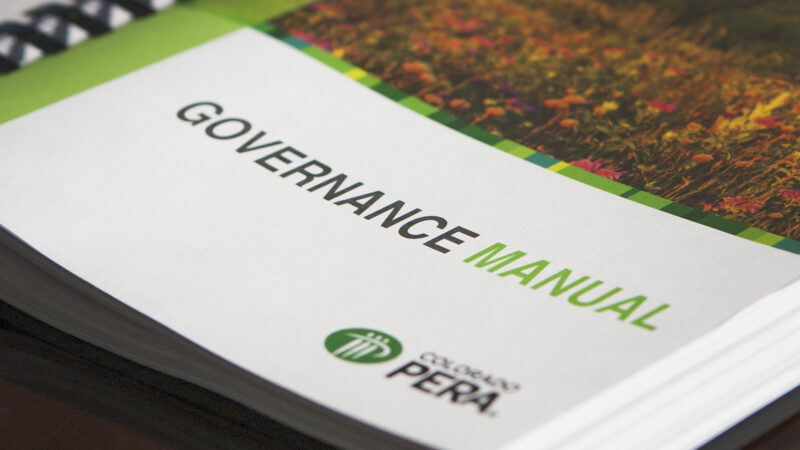Good governance practices don’t always draw headlines. But staying
out of the news may be a reflection of a retirement system that is running
smoothly and adhering to standards that protect the best interests of its members
and retirees as well as employers and taxpayers.
The National
Conference on Public Employee Retirement Systems (NCPERS)
recently issued guidelines for governance best practice for public retirement
systems. The guidelines serve as a checklist, of sorts, for policies,
procedures, and practices of public retirement systems such as Colorado PERA
that help ensure stakeholder needs are effectively met.
According to NCPERS, there is a strong link between retirement
systems that follow best practices and their performance. Research shows that
effective governance may improve long-term investment returns by up to 2.4
percent, annually. And, along with effectively implementing best practices, the
need for retirement systems to communicate about how they work to benefit their
stakeholders has never been greater.
The NCPERS
Best Governance Practices for Public Retirement Systems includes the
following categories of best practice, each of which PERA works to achieve.
Governance Manual
According to NCPERS, “a fund should adopt a governance manual that serves as a central repository for the fund’s primary governance documents.” PERA’s Governance Manual, first developed in 2001 and updated on a regular basis as standards change, provides a framework and starting point for our oversight and governance functions, including:
- Summaries of statutes, regulations,
and Board practices; - PERA’s Mission and Vision;
- Board policies, including the Board Performance
Evaluation Policy.
Board Practices
Board practices
can have a proven impact on performance and risk oversight. The PERA Board of
Trustees engages in best practices to ensure strong oversight and plan
performance. A few practices are:
- Development of a strategic plan, updated for 2019-2023;
- Undertaking Board evaluations, as
referenced in the Governance Manual; - Conducting actuarial valuations to inform the Board of the fund’s
future financial needs; - Using asset allocation studies to
identify asset mixes for meeting future financial needs; - Voting its proxies.
Board Policies
The PERA Board
has adopted several policies designed to guide the retirement system to its
stated goals, such as:
- Standards of conduct, ethics and conflict
of interest rules, such as those included in the Governance Manual; - A Board Communications Policy that
facilitates effective communications and outlines standards and procedures for
trustees and executives, included in the Governance Manual; - An Investment Policy that includes goals, monitoring
procedures, and Board risk tolerances.
Risk Oversight
PERA’s risk
management includes policies and assessments that provide accountability:
- Risk assessments (e.g. audits) that test controls and potential
outcomes of risk events; - Early adoption of sensitivity analyses,
some of which is included in the CAFR; - Key measures, such as signal light reporting, that assess risk exposure.
Strategic Planning
Strategic
planning is a hallmark of successful organizations. PERA’s Strategic Plan, newly updated in 2019, includes several
components. A few examples consist of:
- Goals and performance measures for key
functions; - Review of long-term investment goals,
investment risk tolerances, and diversification objectives; - Succession and leadership development
plans and refreshed Board policy.
Reporting: Key Performance and Risk Measures
PERA issues a
number of performance and risk reports, many of which are compiled within the
annual CAFR.
A few highlights:
- The funded ratio as measured by the
ratio of fund assets to fund liabilities; - Net annualized investment returns
relative to the return assumption and benchmarks; - Future benefits owed to members as
measured by the actuarial accrued liability; - Net assets available for benefits.
PERA also reports on the results of its effectiveness with members through the
annual CEM Benchmarking review of service and cost, incorporating:
- Timeliness and accuracy of
distributions paid to members and beneficiaries; - Member satisfaction with fund services
as measured by surveys and correspondence.
Stakeholder Communications
PERA regularly
communicates with members and other stakeholders through the website, publications, PERA
on the Issues, and other resources. A few of these include:
- A mission
statement that describes
the fund’s purpose to members and the public; - Surveys that measure participant
satisfaction, while providing a basis for improvements; - Updates, letters, annual reports on fund operations and forms for
member beneficiaries.
At PERA, we strive to exceed expectations and to provide
transparency into complex operations. These policies and practices establish a
foundation to ensure that PERA operates as an efficient, trustworthy partner in
providing retirement and other benefits to more than 600,000 current and former
Colorado public employees.
Actuarial valuationAn annual assessment of a pension plan’s finances and membership. This forms the backbone of the plan’s annual financial report.Asset allocationAn investor’s mix of stocks, bonds, and other investments. PERA’s strategic asset allocation is set by the PERA Board of Trustees.BenchmarkA tool used to measure performance. For example, an investor can use a stock index as a benchmark to measure his/her own investment performance compared to the market as a whole.BenchmarkA tool used to measure performance. For example, an investor can use a stock index as a benchmark to measure his/her own investment performance compared to the market as a whole.





I don’t know how long this governance Manuel has been in place but years back the board & president of
PERA must not have read this nor did they comply. What they did is put PERA in the financial state that
it is in right now. PERA was fully funded before the enept board and president put in place where employees could Buy Back years of service so millions (I have no idea how much) of dollars were given
back to the employees that should never have happened. After the funds were given back PERA ended
up in the red and became unfunded and has spiraled down ever since.
The reason I know this is because my husband was a teacher in Aurora and then Westminster for 32 years
and this came at the time he was working. He did not take the offer as he felt it was not a good idea and would end up causing financial damage for the future retirees which it has. Now PERA is unfunded and will be forever.
It was interesting to read this Manuel and truly hope that present and future board members and presidents
do not make these poor decisions.
Dear Ms. McClellan,
Thank you for your comments. Before the Board of Trustees began their work in 2017 to ensure the PERA trusts reached full funding, this article on the sources of underfunding was posted so that the causes of the funding decline would be understood. https://www.peraontheissues.com/index.php/2017/12/26/sources-of-peras-unfunded-liabilities/
You’ll see that the major sources of underfunding can be attributed to (1) less than anticipated investment income ($14.8 billion), (2) changes in plan assumptions and methods ($10.6 billion), and (3) contribution deficiencies ($4.6 billion). You are correct that allowing members to purchase service credit at less than the cost to provide the benefit was a source of underfunding, but not the primary cause that resulted in legislation in 2018 (SB 18-200). The cost to purchase service was increased to full actuarial cost (the cost of the benefit) in 2006.
If by “good governance” they mean supporting legislation that broke promises that current retirees counted on when making decisions, then they are doing a good job.